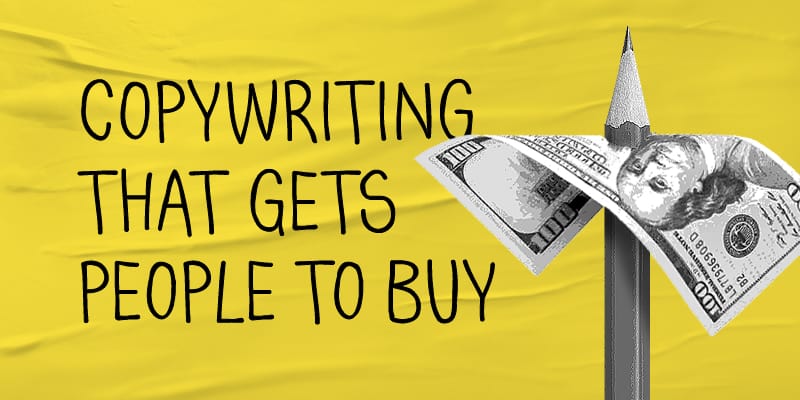
Great direct response copywriting is like a mirror. A skilled copywriter can make us see ourselves in their copy. It almost feels like they’re typing our thoughts back to us.
Not tuning your copy to WIIFM (what’s in it for me) is where most copy goes wrong. Pay attention to the websites, emails, and ads you come across each day and you’ll notice “I”, “we”, and “our” used far more than “you”, “your”, or “yours” throughout the copy. These selfish sites, emails, and ads mean opportunity for you.
You may not be the next Hemingway (I’m certainly not), but you can write a persuasive piece of marketing that feels like it’s written individually for each customer. You just need a framework that helps you build a mirror for your readers.
That’s what I’m giving you here, a direct response copywriting framework anyone can use to construct a landing page, email, or ad that gets results. Open up a Google doc and let’s build an outline.
Who do you want as a customer?
Everything starts here. Spitting out a generic message in an attempt to please everyone is a quick way to produce a bland piece of marketing. You have to zero in on a specific group of people to write something that feels like it’s speaking to an individual.
Write down who you want as a customer at the top of your outline. Go as narrow as possible to start. You can always open up to a wider group of people later. I often write to one specific person. This helps me focus the message and sound more conversational. I’ll literally address the outline to them and remove it later.
What Problem do they have?
Worry less about what you sell and more about why your customer is buying. You won’t write anything persuasive if you can’t define your customer’s problems or desires. Every great piece of direct response marketing starts in the head of the customer.
What keeps them up at night? If you don’t know, ask them. Write down a list of problems that your customers have on your outline. Don’t worry about editing at this point. Just get a thorough list of problems that are pestering the folks you want to buy.
How do they describe their problem?
Understanding your customer’s problems is a start. Knowing how they talk about those problems is the Special Sauce that we’ll slather all over your marketing to make it irresistible, but how do you get this info?
Talk to your customers—duh.
Ask them questions and collect testimonials. If you’re a new business without customers, read competitor testimonials, go through book reviews, and hunt down forums or social posts where people are venting. Find anything you can where the customer you want is talking about their problems.
Write down the specific words and phrases they use to describe their issues. Transcribe full stories that you come across. Put these phrases under the problems you listed in the previous step.
Once you’ve got a thorough list, narrow it down to the problems that pop up repeatedly. Those are your buttons to push.
What does life (or their business) look like if they do nothing?
At this point, we’ve struck a nerve by calling out the problem our customer has. It’s time to transition toward conversion. We need to show them what happens if they don’t take action.
Paint a picture of their future without your product. Show them how a failure to act leaves them stuck with the same frustrations. Make it clear that the headache won’t go away without Aspirin.
How does life (or their business) improve if they take action?
We’ve shown them the cost of inaction. The next step is explaining the benefits of action. Paint a masterpiece of the glorious results they’ll enjoy with your product.
Give them a glimpse of the potential for their life or business. Make the action step feel obvious and simple. Put their dream life or business right out in front of them to grab.
What proof can you show them that you’ve delivered for others?
Finally, share proof your product worked for other people to kill any doubt or questions they have. Make them feel confident in their decision to give you money. We’re all skeptical. Testimonials, case studies, customer videos, and prominent logos are all ways to put our worries at ease.
Now convert prompts into copy
You’ve got everything you need to create a persuasive piece of direct response marketing at this point. These are the prompts you should have answered on your outline…
- Who do you want as a customer?
- What problem do they have?
- How do they describe their problem?
- What does life (or their business) look like if they do nothing?
- How does life (or their business) improve if they buy?
- What proof can you show them that you’ve delivered for others?
Now go through and shape your answers into a headline, sections, subheads, and bullet points.
Prompts 1 and 2 form your headline…
We help ______ do __________.
The first blank is the customer you want and the second is the problem you solve for them. I call this your brand one-liner. If you don’t have one, take a minute to build a full brand script.
Prompts 2 and 3 form your second section where you use their language to poke their wounds. Show them they’re in the right spot. List out the problems they’re facing using their words. Make them feel like you’re writing to them.
Prompts 4 and 5 are the perfect third section following a list of their problems. You’re going to give them a glimpse of their future if they do or don’t take action. This is a powerful section where your product starts to be the focus and you slip in product details.
Prompt 6 becomes the final section where you provide proof that your product has delivered for other folks. Social proof eases anxiety around parting ways with their hard-earned money.
That’s all there is to creating a persuasive website, email, or ad. This little direct response copywriting framework is good for anything from snack brands to b2b consulting. The one tweak you consumer brands may need to make is swap out the word desire for the word problem.
Enjoy simple tips like this that help you grow your company? Grab The Recipe and I’ll send you more I’ve tested and proven through launching, rebranding, and growing hundreds of companies.
